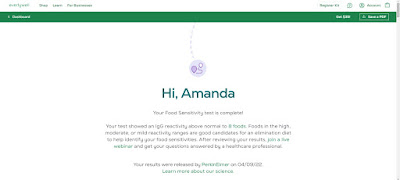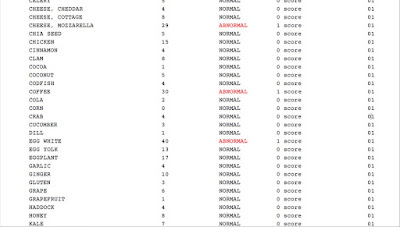Don't Be So Sensitive! Part 2
Did you read Part 1? This blog post won't make much sense without it...
When last I blogged, I documented my recent experience taking the Everlywell Food Sensitivity Test, including the ridiculous process of bleeding myself dry while attempting to fill out the collection card (ridiculous because of me and my super-clotter fingers, not because of anything Everlywell did).
As I mentioned in the previous blog, I received my testing kit in the mail and filled it out on Monday, 4/4; I mailed it back on 4/5, a Tuesday. According to the Everlywell website, they received it by Friday, 4/8, and around 4pm on Saturday, 4/9, I received an email saying my results were ready! Honestly, I was not expecting it to be so darn fast - almost everything involved in the medical realm is taking much longer these days - but I was happy to log on and view my results.
In looking at the site, I was happy to note that my results were actual results, not a message saying the lab couldn't process my sample since I didn't give them enough of my blood. Whew! No more stabbing holes in myself (at least for the foreseeable future).
Before we dive into my specific results, it's worth noting what the Food Sensitivity Test measures and what it doesn't. When the lab ran my blood, they were looking for IgG antibodies; how these antibodies reacted to certain foods would show them which I was reactive to and at what level. If I was fairly reactive to a food, there's a good chance I would also be sensitive to it, which could be contributing to the concerns I've been having (as I mentioned in Part One of these posts, mild bloating, gas pain/pressure, migraines, plateauing weight loss). This is totally different from actually being allergic to a food, which is something you can measure based on your IgE antibodies (but not in this test - so, my theory that I'm allergic to coconut will live on yet another day). The test I took also doesn't measure for actual diseases, like Celiac's, or intolerances, like to lactose, as those also don't use IgG markers.
The Everlywell results website divides the scale of reactivity into four quadrants: normal reactivity, mild, moderate, and high. The lab that examined my blood came up with a number ranging from 0 to 255 for each of the 96 foods on the list, and the higher the number, the more reactive my IgG antibodies were to that food (the numbers seem to be noted as UODs or Units of Optical Density. I assume this involves microscopes somehow. I am likely totally wrong). It's also worth noting that if you haven't eaten a certain food on the list in the last six months or so, your results may not be accurate for that specific item, as your IgG antibodies wouldn't be reacting to them if they weren't currently in your system.
According to the site, I didn't have any foods (of the 96 common ones measured) fall into the highest quadrant, and I only had one fall into the moderate category: cow's milk.
Sorry these are kinda small -
click them to make them bigger.
Even though cow's milk is in the moderate range, it's on the high end of that range, which means it's likely a trigger for me.
I also had 7 foods that fell into the mild range, including baker's and brewer's yeast, coffee, egg white, lamb, mozzarella cheese, and yogurt.
The rest of the foods measured - all 88 of them - were considered to be normal:
I'm going to add screenshots of a PDF of my results
(minus any sensitive information)
at the bottom of this post,
so if you want to know what the other 88 foods are,
as well as my specific numbers,
please check it out there.
So, what does this mean and what do I do now?
What it means: Everlywell is very clear in noting that while my IgG antibodies were like, b*tch, please, about this set of foods, that doesn't necessarily correlate to all of those foods being a current cause of the symptoms I experience. For example, lamb is on my list, but I consume it so rarely (once a year? maybe?) that it's more than likely not a serious culprit for me.
Next steps: The site recommends trying out an elimination diet for your highest reactivity food(s) for 30 days, followed by consuming a normal dose of that item for one day, followed by another elimination of 4-5 days. If taking out that reactant helps the symptoms subside and then they come roaring back after that one day of use, you might have a pretty good idea of what's freaking out your body. The site also offers a few other plans for elimination diets if you can't do the full 30 days, or if you have other dietary concerns that make it hard to make that plan work.
My current plan is to start with my highest potential trigger - cow's milk - and take it out of my diet for 30 days (4/11-5/12), along with three mild options, coffee, lamb, and yogurt (the first two are easy removals for me, as I don't consume them much anyway, and yogurt aligns with cow's milk, so it's covered already). I am under no illusions - this is going to be lame. While I don't drink milk in its most standard form (I haven't for years), cow's milk goes into soooo many things, including the canned chai latte mix from Trader Joe's that I've used to start every day for around the past five years. As you might be able to see in one of the pictures above, no cow's milk also means no yogurt, sour cream, baked goods (no pancakes, waffles, cookies, cakes, certain breads), ice cream, white sauces, creamy soups, and the like. Apparently, cheese is measured on its own due to its casein levels being far lower than milk, and different types of cheeses can ping independently on the scale (hence me being reactive to mozzarella, but not cheddar or cottage cheese); when you're doing an elimination diet for cow's milk, however, Everlywell recommends taking out ALL sources, including cheese and butter.
I think I can make it work at home without too much of an issue, but eating out is going to be a challenge, I already know. I guess the next month will involve me politely bugging waiters to ask the chef if something is sauteed in oil or butter, and/or trying to select places where it's totally transparent on how they prepare their foods and all that (many national and local chains have allergen menus, which you can find online pretty easily). Even just pondering this makes me extremely grateful for the folks that have come before me, trying to negotiate this while dealing with allergies and sensitivities that result in reactions far more severe and significant than mine.
On 5/13, I'll try a normal serving of chai for the first time in a month, and I'll see how I react (in addition to likely hovering slightly above my office chair for most of the day - that amount of sugar and caffeine crashing into my system after a month's absence could make things interesting). If the chai isn't a problem for me, then I might be able to reintegrate this and other cow's milk items into my diet again; alternatively, if it does cause a reaction, then I'll know what I can expect, should I choose to eat/drink these things again. Thankfully, we're living in a golden age for dairy substitutes, so if it turns out cow's milk is a major trigger for me, and I don't want to deal with its effects, I could potentially pivot to almond milk in lattes (or just drink something healthier, like hot or iced tea); we also have an amazing vegan bakery/coffee shop right around the corner from us, so my baked goods needs are covered, too (Sprouts normally has a decent vegan selection as well).
As for coffee and lamb, I'll eventually do a one-day test of each of those, too, but my current plan is to stagger these out over a few weeks. These aren't huge parts of my life anyway, so it seems weird that they might be the true issues. Also, I'd want to ensure I was isolating each one properly to minimize the chance I confused symptoms from one with symptoms from another.
Of course, there's also the possibility that cow's milk, coffee, lamb, and/or yogurt aren't issues for me at all, and I continue experiencing symptoms far into my 30 day elimination diet. That would likely mean that something else is the culprit, and I'd need to consider another elimination diet based on one of my other mild potentials: baker's yeast or brewer's yeast. Personally, I'm doing my best not to focus on this right now, as the thought of not being able to eat any sort of leavened carbohydrate or drink beer, wine, cider, mead, etc is a bit too much to ponder. If I had to do elimination diets of these, I don't know if it would be better to do both at the same time and just be an absolute nightmare of a human for a month - or - do one then the other for 60 days total, potentially being less horrible for Chris to deal with, but for longer. Decisions, decisions.
As I've been setting up my plans, I've been doing a lot of reading and research, most of it on the Everlywell site, and I've been really impressed with their resources. Right away, I was able to watch a 30 minute recording on how to interpret my results and next steps to take, and I also attended a live video/group call with a member of Everlywell's medical staff. While the first half of the call involved listening to a nurse reiterating the same information covered in the automated recording, the second half of the call was a Q&A session where that same nurse answered all of the questions we typed into the Chat box live and on the air. I was able to ask about butter (yes, it's included in the general "cow's milk" classification) and listen to the responses to the questions from the other folks on the class, which was helpful in a more general sense.
I'll keep everyone posted on how everything goes!
Later!
Amy
PS - As I mentioned in last week's blog post, if you want to try this out on your own, here's my referral link. You get a 15% discount and I get an Amazon gift card. Win, win!
Also, here are screenshots of my PDF test results, with all of my scores and the listed foods:
I really like the giant red "ABNORMAL" label.
That makes one feel nice.












Comments
Post a Comment